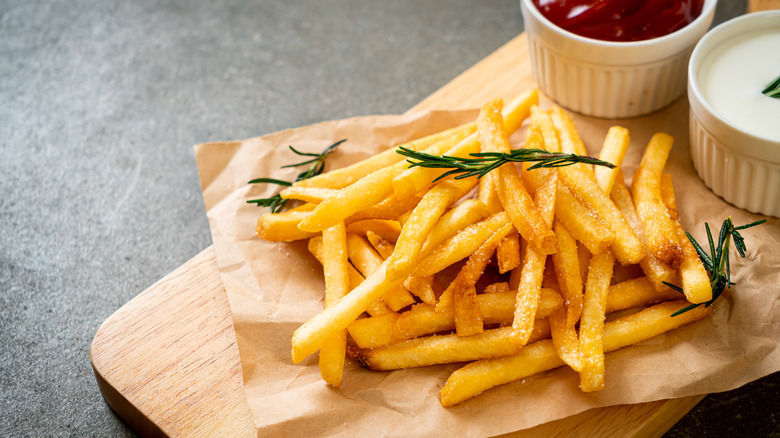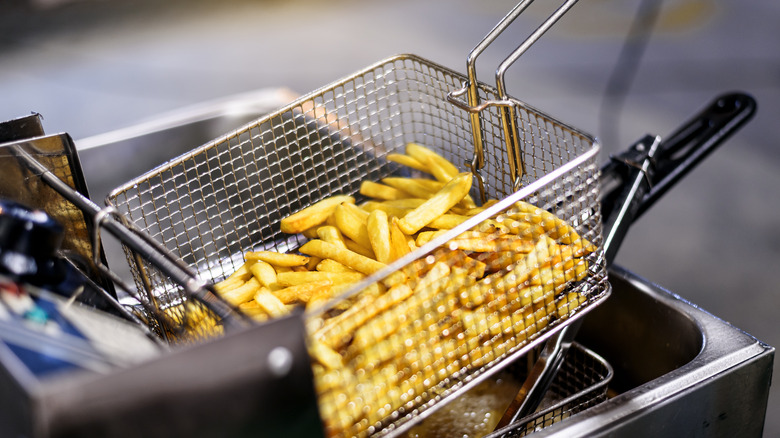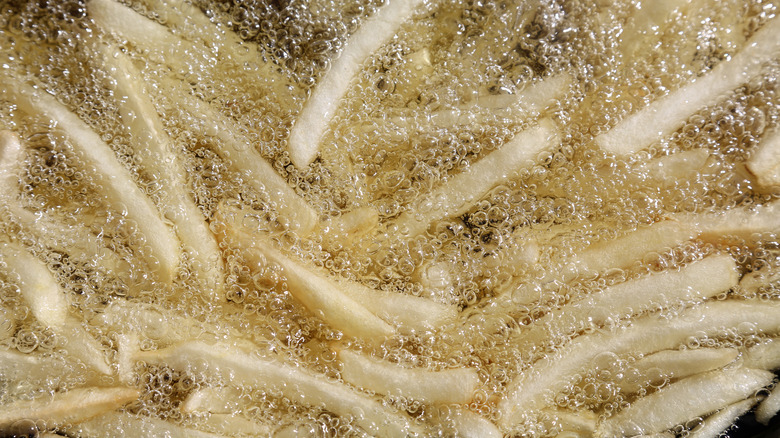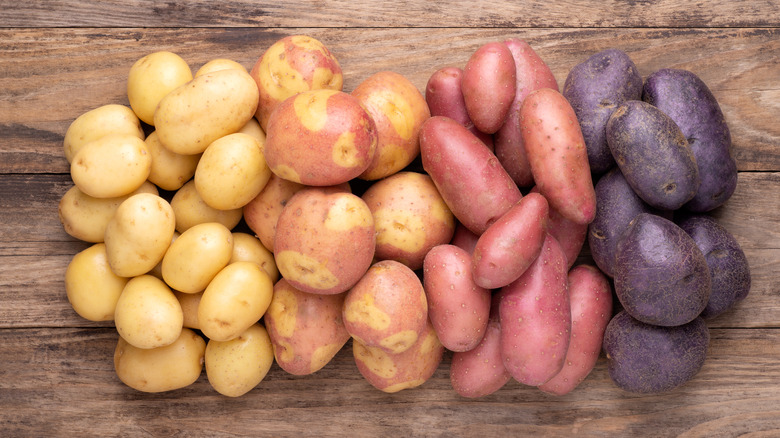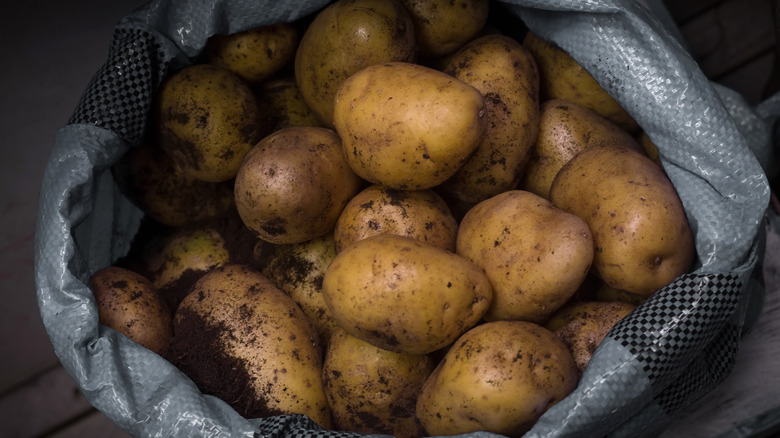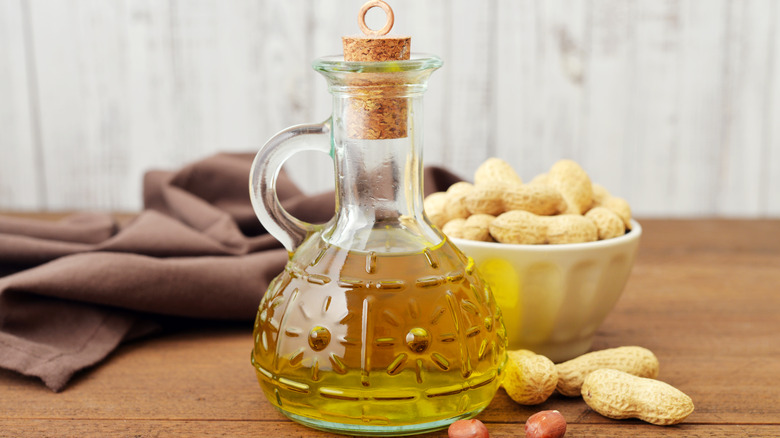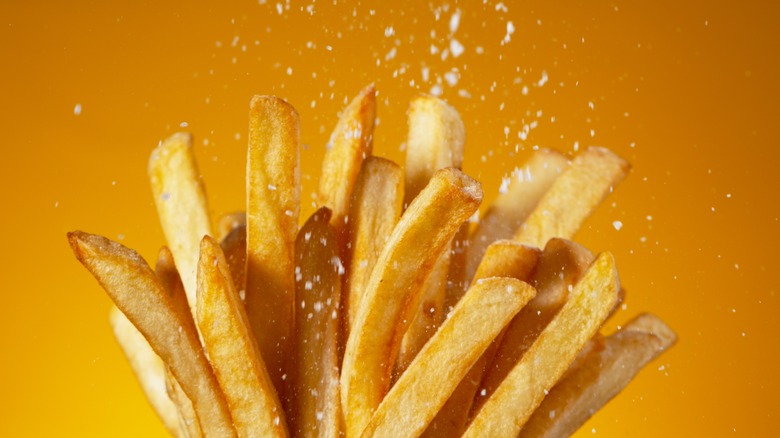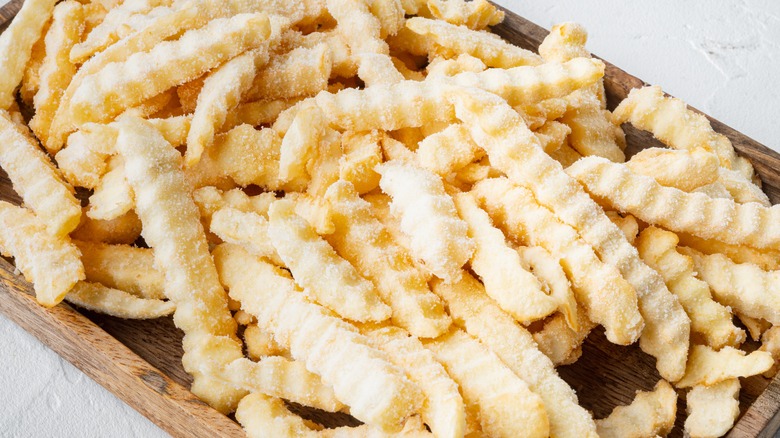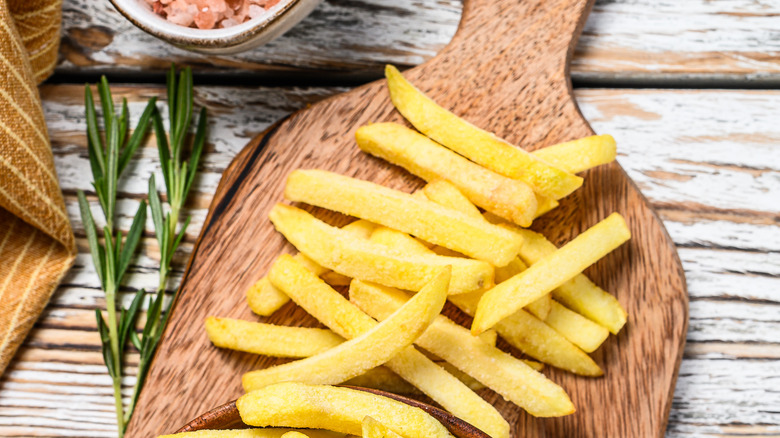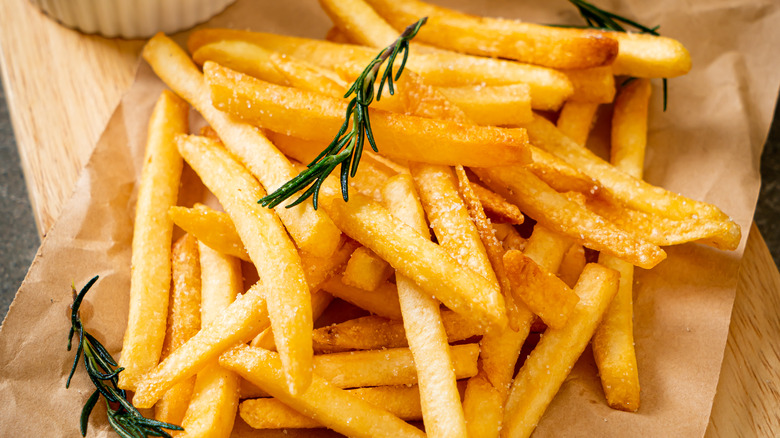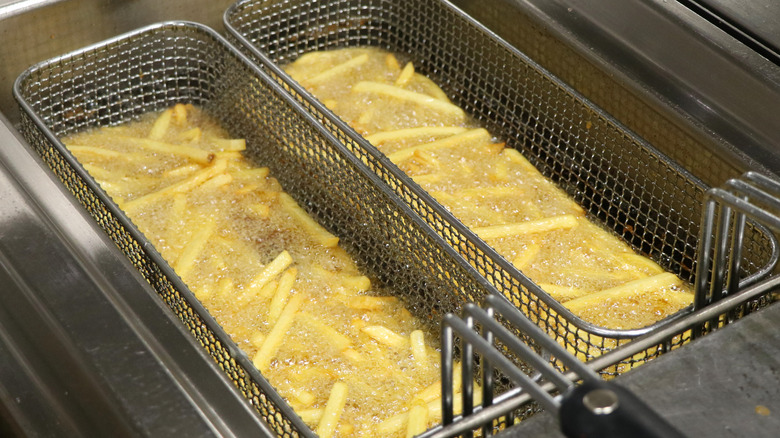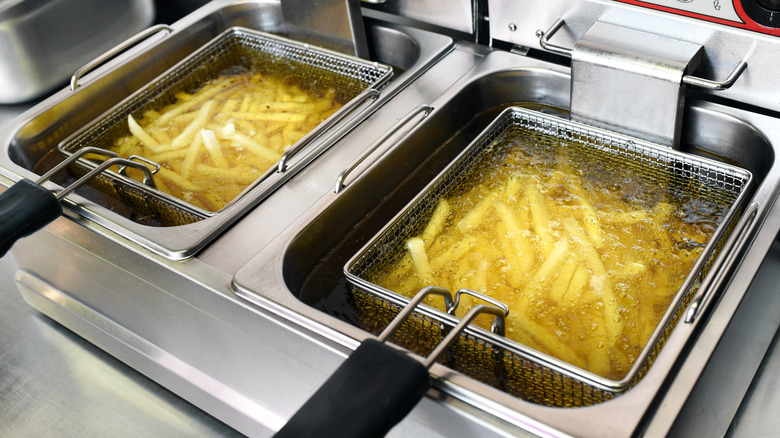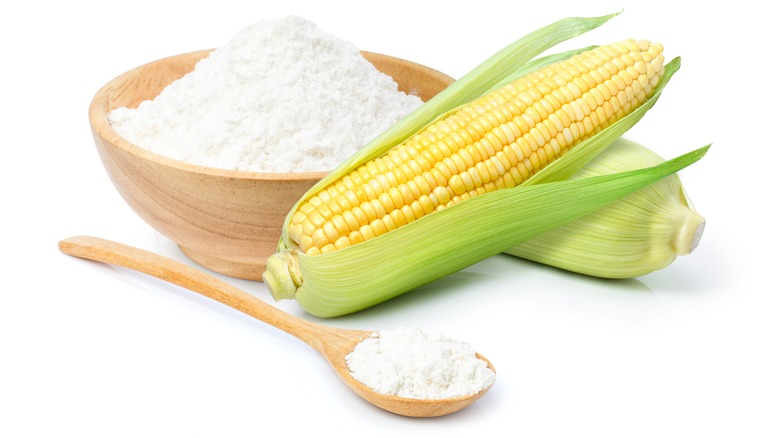Why French Fries Always Taste Better At Restaurants
If you're the average restaurant-going American, you likely consume about 29 pounds of french fries each year. That's about the size of an average 3-year-old or the equivalent of 77 large orders of McDonald's fries (via National Geographic). In all that fry eating, you've probably discovered that french fries tend to taste better from restaurants than when you try to make them at home.
So, what are you doing wrong? And what exactly are restaurants doing right? Making restaurant-quality french fries at home comes down to using the correct type of potatoes, oil, and cooking method. For example, most restaurants fry their fries twice. Plus, they often soak their fries in a slurry of special ingredients before freezing them for later. Once you realize what restaurants are doing differently and what the science is for achieving crisp, golden fries, you can produce better fries at home that taste just like restaurant fries.
Restaurants fry french fries twice
One of the secrets to how fast food restaurants make their french fries crispy is that they double fry them. The result is a french fry that's soft inside and crispy outside. The reason has its basis in science. Food scientist Dr. Arielle Johnson and celebrity chef Jet Tila demonstrated the process in a Popular Science video. They start out by soaking the fries in cold water to remove excess starch and then pat them dry. Johnson said that when you heat the potato through frying the first time, the starch granules inside start to let water in and soften through the "starch gelatinization" process. You only need to fry the potatoes the first time for about five minutes. The first round of frying yields limp, greasy fries, but that's exactly what you want to ensure the final fry is soft inside.
After your first round of frying, you'll want to remove excess grease from the surfaces, and some cooks choose to freeze the fries before the second round of frying (via NPR). If restaurants like McDonald's don't appear to double-fry their fries, it's because they're using frozen fries that have already undergone an initial flash fry before freezing (via Swizzle). Johnson says that during the second round of high-temperature frying, the remaining water fries away, leaving behind a fry that's crisp outside and soft inside.
Restaurants fry french fries at two different temperatures
To accomplish a soft yet crispy fry, temperature matters. When restaurants double fry their sliced potato strips, their first round of frying is at a lower temperature than their second round of frying. During the first round of frying, the goal isn't to brown the french fry; it's to soften up the inside of the potato to make it pillowy and creamy. However, the second round of frying is all about developing a crisp, golden-browned outside.
In the Popular Science video, food scientist Dr. Arielle Johnson says that, during the second fry, the key to a beautifully browned surface is to activate the Maillard reaction. She explains it as "the reaction between naturally occurring sugars and amino acids in ingredients brought to a high temperature." According to food chemist Harold McGee, the first stage of frying should be for eight to 10 minutes in oil that is 250 to 325 degrees Fahrenheit. The second stage should be in hotter oil around 350 to 375 degrees Fahrenheit for about 3 to 4 minutes (via "On Food and Cooking").
Not all potatoes work the same for french fries
When you decide to make french fries at home, you shouldn't just grab whatever potatoes you have in the pantry because not all potatoes fry up the same. Restaurants know that the best type of potato for french fries is starchy rather than waxy. If you don't pay attention to the type of potato you use to make your fries, you'll end up with fries that don't taste as good as the ones you get in a restaurant.
Starchy potatoes are high in starch and low in moisture. When starchy potatoes heat up, the starch inside separates to make fluffier french fries. The most iconic starchy potatoes are Russet potatoes, and they're perfect for french fries (via MasterClass). Scientists have also discovered that carb-laden foods provide us with a satisfying sixth "starchy" flavor to go along with sweet, sour, bitter, salty, and umami (via New Scientist).
Meanwhile, MasterClass says you'll want to avoid using waxy potatoes for french fries because they have a lot of moisture without a lot of starch. It's best to save your waxy potatoes for dishes that need the potatoes to be able to hold their shape, like potato salads, gratins, or soups. Waxy varieties include yellow potatoes, red potatoes, and fingerling potatoes (via Potato Goodness).
Restaurants use cellar-aged potatoes
Restaurants know that cellar-aged potatoes are best for making french fries. You'll want to store potatoes for your french-fry making at about 55 degrees Fahrenheit in a dark place in covered containers to duplicate the way growers store them. The ideal storage location should have about 95% humidity as well. Cellar aging causes the potatoes to go dormant so that they don't sprout while you store them (via Idaho Potato Commission).
Cellar aging in the dark also prevents an increase in toxic solanine on the surface of the potatoes (via Michigan State University). If you peel a potato and find green flesh beneath it, that means the potato has been exposed to too much sunlight. When you eat enough spuds that are green beneath the skin, you run the risk of developing solanine poisoning symptoms such as vomiting, diarrhea, or headaches. In worse cases, the toxins can cause paralysis, comas, and even death. How it affects you depends on how much you eat, how much you weigh, and how tolerant you are to alkaloid poisonings. So, a small child could develop poisoning from eating fewer green french fries than an adult (via Michigan State University).
The correct type of oil matters when making french fries
Restaurants use neutral, high-smoke-point oils to fry their french fries. The smoke point is the temperature at which oil begins to break down and smoke. Once oil reaches the temperature at which it smokes, it gives off a burned flavor and releases harmful polar compounds that have been linked to various health issues (via Michelin). So, not only does using a high-smoke-point oil keep your french fries tasting their best at the high temperatures necessary for crisping your fries, but it also keeps you healthier.
According to Michelin, cooking oils with the highest smoke points include avocado oil, refined vegetable oil, safflower oil, sunflower oil, peanut oil, canola oil, and grapeseed oil. However, you will want to avoid refined vegetable oils for frying because they have already been exposed to heat and break down easier. While some restaurants like McDonald's once fried their fries in lard or beef tallow, the lard-usage practice largely changed in the 1990s as people started to worry about high levels of cholesterol and saturated fats in their foods (via Now I Know).
A good seasoning blend can make a difference
While french fries have a starchy, carb flavor that is pretty amazing on its own, restaurants add seasonings that elevate the flavor. The most basic seasoning to add to fries after cooking is salt. When chef Samin Nosrat, the author of "Salt Fat Acid Heat," talked with NPR, she said that salt brings the aromatic qualities of vegetables to the top, which can make fries taste more like themselves. So, the first step to seasoning french fries in a way that makes them taste as good as restaurant french fries is to add salt.
However, there are plenty of other flavors that go well with potatoes, such as onions (think onion powder), garlic, curry powder, parsley, pepper, rosemary, and thyme (via Produce Made Simple). The king of amazing restaurant fries, Five Guys, uses salt and a proprietary seasoning on its Cajun Style Fries. Meanwhile, food celebrity Rachel Ray jazzes up her french fries with salt, coriander, and cumin (via Instagram). She says that these spices are "best friends, and they like to go everywhere together." You can season your fries to fit your mood or to fit the flavor profile of the other foods you're eating with your fries. Just don't forget the salt.
Restaurant french fries are often frozen or dried to achieve the perfect texture
Many restaurants like McDonald's start with frozen or dried fries that have already undergone an initial flash-fry phase (via Swizzle). Because the fries are partially pre-cooked, you end up with a french fry that is soft and fluffy on the inside and crisp on the outside. Another advantage to frozen fries is that restaurants often coat them with ingredients like potato starch or cornstarch before freezing to enhance their texture and crunch (via Sporked).
While you can pre-fry your fries yourself and freeze them, there are plenty of partially cooked popular frozen French fry brands that can make your french-fry-frying endeavors a little easier. When Mashed surveyed 657 people in the U.S. in 2021 to discover their favorite frozen french fry brand, Ore-Ida got 62.71% of the votes. The second-place winner, Whole Foods 365, only got 9.89% of the votes.
One mistake you want to avoid making with your frozen french fries is allowing them to thaw before cooking. While fries may cook faster when they're thawed, keeping them frozen will keep the surface of the potato sealed so that it will result in a crisper french fry (via Idaho Potato Commission).
Uniform french fry sizes yield more consistent results
There are a variety of french fry cuts ranging from standard fries and waffle fries to curly fries and crinkle-cut fries. If you think about the last fries you got from a restaurant, their shape was likely mostly the same. U.S. Grade A frozen french fries must meet specific quality standards, including being "practically uniform in size and symmetry." If they're only "reasonably uniform," they're considered to be U.S. Grade B (via U.S. Department of Agriculture). A big reason you should use fries that are similar in size and shape is that you want them to all finish cooking at the same time. If you have some tiny slivers of fries in with the same batch as big fat fries, some of your fries will burn in the time that it will take for others to get done.
It's entirely possible to cut your french fries by hand. However, you'll get more uniform results with a dedicated french fry cutter. If you make french fried potatoes often, a cutter can save you time and help you create more uniform cuts.
Deep-fried potatoes taste better than air-fried or baked
Air-fried and baked french fries are certainly healthier since they don't require as much oil as deep-fried potatoes. However much you want to fool yourself, air-fried and baked french fries never taste as good as potatoes fried in hot oil. So, if you make it a point to always eat "healthy" fries at home, you're not getting the full flavor experience at home as you do from deep-fried potatoes from restaurants. While you might sprinkle a little bit of oil on your air-fried or baked fries, you're not fully submerging them and covering them with oil on all sides as you do in a deep fryer.
Samin Nosrat, author of "Salt Fat Acid Heat," told NPR that "fat is mostly about texture." However, she also says that each type of fat has its own flavor that it imparts to foods like french fries. Fried foods are popular because they're comfort foods, and deep-fried restaurant french fries have the power of nostalgia behind them (via The Wall Street Journal).
Restaurants have the correct equipment to achieve the perfect French fry
Restaurants can create perfect french fries because they have temperature-controlled fryers that can ensure consistent results. If you're trying to fry fries on the stovetop -– especially with an electric range -– it can be more difficult to keep your oil at a consistent temperature. Even if you keep a food thermometer in the oil, you may find yourself having to constantly adjust the heat dials on your stove to keep the oil in the proper temperature range.
While you can use a wok or Dutch oven on the stovetop for frying, investing in a dedicated deep fryer will make cooking french fries at home much easier. Because the temperature stays consistent and many fryers come with timers, you don't have to worry as much about getting the oil beyond its smoke point or burning your fries. Of course, restaurants have fancier deep fryers than what most home cooks add to their kitchens. Commercial fryers have larger capacities, may have built-in filtration, have quick recovery times between batches, and may even be connected directly to the gas line (via Webstaurant Store).
Using aged oil makes french fries crispier
Cooking oil has a variety of stages ranging from too fresh to deteriorating and ready to toss. If you fry fries in oil that's too new, your fries will be pale and possibly limp. And nobody wants fries fried in old, dark, and rancid oil. However, when you fry potatoes in oil at its peak quality, you'll end up with beautifully golden and perfectly crisp fries. Cook's Illustrated found that mixing a little used oil with fresh oil provides you with food that is more crisp and golden than using fresh oil alone.
Cook's Illustrated says that when you heat oil, it breaks down into "slippery, soaplike compounds that can penetrate the water barrier." When oil starts to break down like this, the oil is better able to reach the surface of the food to brown and crisp it.
When Cook's Illustrated experimented with oil quality, it found that you can fry potatoes far more times in the same oil than battered foods like fried chicken. It stopped testing after the eighth round because the oil remained clear. However, there is a limit to how long you should continue to use oil. A 2013 study determined that oil has a frying life of about six hours before it starts deteriorating to become unhealthy and affects fried food quality. So, if you save your oil to reuse for more fries, you'll want to keep track of how much total time you've used the oil.
Restaurant french fries often contain extra additives
If you think that restaurant french fries are nothing but potatoes, you'd be wrong in most cases. The truth is that restaurants' food production plants often coat restaurant french fries in other ingredients before freezing and shipping. A quick look at the ingredient list for fries from Wendy's reveals that, besides potatoes and cooking oil, the fries are coated with four types of food starch, rice flour, salt, leavening, dextrose, xanthan gum, and a chemical to help them retain color. McDonald's coats its fries with natural beef flavor (derived from wheat and milk), dextrose, and a chemical to help prevent the potatoes from graying or browning when exposed to air. The starch helps make the fries crispier (via Sporked). Meanwhile, since dextrose is a type of sugar, it helps with the browning process when the fries reach high temperatures (via ABC News).
If you want to make fries at home that taste like restaurant fries, you can't just throw a handful of potatoes into your fryer. Instead, you'll want to add crisping and flavoring components. For example, if you want to make copycat McDonald's fries, you would start out brining frozen shoestring fries in a slurry of ingredients. Then you would freeze the fries for about five minutes before deep frying. The results are more similar to restaurant fries than frying plain cut potatoes alone.
